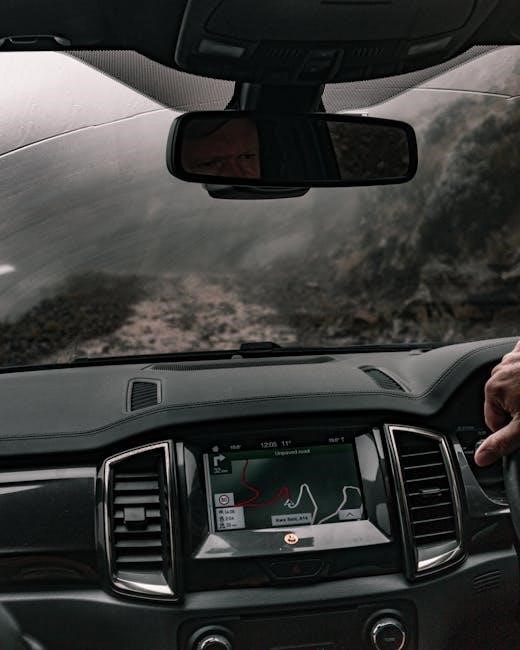Driving Skills Checklist PDF: A Comprehensive Guide
This comprehensive guide provides a driving skills checklist‚ assisting learners and experienced drivers alike. It covers essential areas from basic vehicle checks to advanced maneuvers. This valuable resource helps assess and improve driving competency‚ and ensures road safety knowledge.

Basics Skills Checklist
The basic skills checklist is fundamental for new drivers and a great refresher for experienced ones. It includes vital elements‚ such as properly using seat belts and adjusting mirrors for optimal visibility. Correct hand positioning on the steering wheel is also essential‚ ensuring control and responsiveness. Signaling intentions clearly and at the appropriate times is crucial for communicating with other drivers.
Maintaining appropriate speed for the conditions and keeping a safe following distance are key to preventing accidents. Turning safely requires proper technique and awareness of surroundings. This checklist also covers conducting basic vehicle checks‚ like oil levels and tire pressure‚ contributing to overall safety and vehicle maintenance. Mastering these skills provides a solid foundation for safe and confident driving. It is important to review them regularly.

These basics form the building blocks upon which more advanced driving techniques are based. A strong understanding ensures a safer driving experience for everyone on the road.

Control and Positioning Skills
Mastering control and positioning skills is crucial for safe and effective driving. This involves maintaining a steady speed and smooth acceleration‚ ensuring a comfortable and controlled ride. Proper steering techniques are essential for navigating turns and maintaining lane position‚ enhancing responsiveness.
Effective braking‚ including smooth and controlled stops‚ is vital for avoiding collisions. Positioning the vehicle correctly within the lane‚ away from potential hazards‚ improves safety and visibility. Navigating curves safely requires adjusting speed and maintaining proper lane positioning throughout the turn. Understanding and adapting to different road conditions‚ such as wet or uneven surfaces‚ is also crucial.
Practicing these skills regularly enhances a driver’s ability to react effectively in various situations‚ promoting safe driving habits. Ultimately‚ proficiency in control and positioning ensures greater confidence and reduces the risk of accidents on the road. This creates a smoother‚ safer journey for everyone.
Observation‚ Signaling and Planning Skills

Effective observation‚ signaling‚ and planning are vital for safe driving. Consistent mirror checks enhance awareness of surrounding traffic. Scanning the road ahead allows for early hazard detection and proactive responses. Blind spot monitoring is essential before lane changes or turns‚ preventing collisions.
Accurate signaling communicates intentions to other drivers‚ promoting smoother traffic flow. Proper use of turn signals and hazard lights ensures clear communication. Planning ahead involves anticipating potential hazards and adjusting speed accordingly. Maintaining a safe following distance provides ample time to react to sudden stops.
Identifying road signs and exits in advance enables informed decision-making. Merging into traffic requires careful observation and timing. Navigating junctions safely involves assessing traffic flow and yielding appropriately. These skills‚ when honed‚ contribute to a proactive and responsible driving approach‚ fostering a safer environment for all road users. Mastering these components minimizes risks and maximizes safety.
Advanced Skills Checklist
The advanced skills checklist encompasses maneuvers requiring precision and adaptability. Merging seamlessly into high-speed traffic demonstrates proficiency in speed matching and gap assessment. Navigating toll booths efficiently minimizes delays and ensures smooth passage. Mastering passing and being overtaken involves strategic decision-making and safe execution.
Maintaining appropriate speed in varying conditions showcases responsible driving habits. Adapting to diverse road conditions‚ such as rain or snow‚ demands heightened awareness and control. Executing controlled stops in emergency situations highlights quick reaction time and braking technique. Navigating complex intersections requires astute observation and precise maneuvering.
Identifying and responding to potential hazards proactively prevents accidents. Demonstrating proficiency in defensive driving techniques ensures safety in unpredictable scenarios. These advanced skills reflect a comprehensive understanding of driving principles and a commitment to safe and responsible road behavior. Continuous practice and refinement are essential for maintaining mastery and adapting to evolving driving conditions‚ ultimately fostering a safer driving experience.

Driving Test Checklist Essentials
The driving test checklist essentials cover crucial elements for demonstrating competence. First‚ eyesight must meet the required standards‚ ensuring clear vision for safe driving. A controlled stop showcases the ability to brake smoothly and accurately in a designated area. Mastery of maneuvers‚ such as parking and reversing‚ demonstrates vehicle control.
Vehicle checks‚ including lights and fluid levels‚ confirm pre-drive preparation. Precautions taken before starting‚ like mirror adjustments and seatbelt use‚ emphasize safety awareness. Demonstrating overall control of the vehicle throughout the test is paramount. A smooth move-off from a stationary position indicates confidence and coordination.
Effective use of mirrors for observation is crucial for hazard perception. Knowledge of road signs and traffic laws is essential for safe navigation. Signaling intentions clearly communicates actions to other road users. Maintaining appropriate speed and following distance demonstrates responsible driving habits. Successfully navigating junctions and roundabouts showcases decision-making skills. These essentials collectively assess a candidate’s readiness for independent driving and commitment to road safety.
Vehicle Checks Checklist

Before embarking on any journey‚ performing a thorough vehicle check is paramount for safety and preventing potential breakdowns. A comprehensive vehicle checks checklist ensures all essential components are in proper working order. Begin by verifying that the vehicle has a valid license plate and registration‚ confirming its legal operation. Additionally‚ ensure proof of valid personal injury protection (PIP) insurance is readily available.
Inspect the tires for adequate tread depth and proper inflation‚ as these factors significantly impact handling and braking performance. Check all lights‚ including headlights‚ taillights‚ brake lights‚ and turn signals‚ to ensure visibility and communication with other drivers. Verify fluid levels‚ such as engine oil‚ coolant‚ brake fluid‚ and windshield washer fluid‚ maintaining optimal engine and system function.
Inspect the windshield for cracks or damage that could impair visibility. Confirm that the mirrors are clean and properly adjusted. Finally‚ assess the functionality of the horn‚ ensuring it operates correctly for signaling. Regular vehicle checks contribute significantly to road safety.
Competency Requirements
Meeting specific competency requirements is crucial for safe and responsible driving. These requirements ensure drivers possess the necessary skills and knowledge to operate a vehicle proficiently and safely on public roads. A key aspect of competency is demonstrating a thorough understanding of traffic laws‚ regulations‚ and road signs. Drivers must exhibit the ability to interpret and respond appropriately to various traffic situations‚ ensuring compliance with legal requirements.
Competency also involves demonstrating proficient vehicle control‚ including smooth acceleration‚ braking‚ and steering. Drivers should be able to maintain a safe following distance‚ adjust speed to prevailing conditions‚ and execute maneuvers such as turning‚ merging‚ and lane changes safely and effectively. Strong observational skills are essential‚ allowing drivers to anticipate potential hazards‚ monitor surroundings‚ and react promptly to changing conditions.
Furthermore‚ competency requires maintaining focus and concentration while driving‚ avoiding distractions‚ and remaining alert to the driving environment. Finally‚ drivers should exhibit responsible and ethical behavior‚ respecting other road users and prioritizing safety above all else. Meeting these competency requirements is essential for safe driving.
Beginner Skills Checklist

The beginner skills checklist focuses on the foundational elements necessary for new drivers to operate a vehicle safely and confidently. It starts with basic vehicle familiarization‚ ensuring the driver knows the location and function of essential controls such as the steering wheel‚ accelerator‚ brakes‚ lights‚ and indicators. Proper seatbelt usage is paramount‚ reinforcing the importance of safety from the outset.
Steering control is a key area‚ emphasizing smooth and controlled movements to maintain lane position. Acceleration and braking techniques are introduced‚ teaching gradual acceleration and smooth deceleration to a stop. Turning skills are addressed‚ covering proper signaling‚ speed control‚ and lane positioning during turns. Observation skills are developed‚ encouraging drivers to scan their surroundings‚ check mirrors frequently‚ and identify potential hazards.
Moreover‚ understanding and obeying traffic signals and road signs is fundamental. The checklist includes items on recognizing and responding correctly to various signs and signals. Finally‚ maintaining a safe following distance is emphasized‚ promoting awareness of the space cushion around the vehicle. Mastering these skills builds a solid foundation.
Fitness and Concentration Assessment for Driving

Assessing fitness and concentration is crucial for safe driving‚ evaluating physical and mental readiness. The fitness assessment examines physical capabilities‚ ensuring drivers can comfortably operate vehicle controls. Vision and hearing are tested to confirm adequate sensory perception of surroundings‚ identifying potential hazards. Medical conditions impacting driving ability are reviewed‚ addressing concerns like seizures or diabetes.
The concentration assessment targets mental alertness and focus. It evaluates fatigue levels‚ identifying potential drowsiness affecting reaction times. Stress and emotional state are considered‚ recognizing their impact on decision-making. Medication effects on alertness and cognitive function are assessed‚ ensuring they don’t impair driving. The ability to maintain focus amidst distractions is tested‚ simulating real-world driving scenarios.
Furthermore‚ cognitive functions like memory and judgment are evaluated‚ ensuring sound decision-making. Regular self-assessment is encouraged‚ promoting awareness of one’s fitness and concentration levels. Addressing any deficiencies through rest‚ medical attention‚ or coping strategies is vital. This assessment aims to ensure drivers are physically and mentally prepared for safe operation.
Responding to Emergencies and Law Enforcement
Knowing how to respond to emergencies and interactions with law enforcement is a crucial aspect of responsible driving. In emergency situations‚ drivers must remain calm and assess the situation. Activating hazard lights to alert other drivers is paramount. Knowledge of basic first aid can be invaluable in providing immediate assistance to injured individuals.
Drivers should be familiar with emergency contact numbers and procedures for reporting accidents. Understanding how to safely move a vehicle off the road is essential to prevent further incidents. In the event of a breakdown‚ knowing how to use warning triangles and call for assistance is critical. When interacting with law enforcement‚ drivers must remain respectful and cooperative.

Providing necessary documents‚ such as driver’s license‚ registration‚ and insurance‚ is required. Understanding one’s rights during a traffic stop is important. Following instructions given by law enforcement officers is crucial for ensuring a safe and efficient interaction. Knowing how to respond to being pulled over‚ including safely pulling to the side of the road‚ is also vital. This knowledge equips drivers to handle unexpected situations responsibly and effectively.

